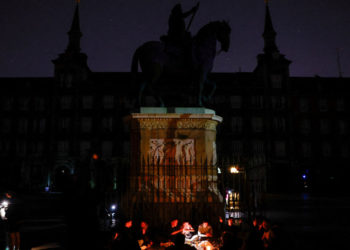In the summer of 2001, Ecuador found itself gripped by soccer fever.
With each match, including a 1-0 victory over the Brazilian giant, residents still reeling from a financial crisis were lifted out of their funk, carried along on a country-consuming wave of hope as the men’s national team sought to qualify for the World Cup for the first time.
That period — one filled with the palpable excitement that Ecuador was set to arrive on the world stage (which it duly did) — looms large in the imagination of Julián Cordero.
He was only 4 in 2001 yet has “idealized” the time, theorizing that its horizon-shifting power was formative for his generation. So Cordero set out to make a video game about it from the perspective of a child in Quito, Ecuador’s mountainous capital.
His game, Despelote, is a reconstructive voyage into this halcyon period, a narrative adventure that gives players not gun battles or dragon-slaying quests but more humdrum activities: skipping class, causing mischief and, naturally, kicking a soccer ball about in the park for hours on end.
You play as a lightly fictionalized version of a young Cordero, having to orient the first-person camera upward to look at everything. Its 3-D world is made from photographs of actual neighborhoods in Quito, rendered in a dreamy impressionistic style that evokes Cordero’s own act of remembering. The bustling, excitable sounds that waft through these settings are field recordings.
Despelote, which is being released for the Xbox Series X|S, PC and PlayStation consoles this week, is a striking hybrid: video game, autofiction and documentary all at once. It was born from Cordero’s own philosophical conviction that video games are “obsessed with creating worlds” at the expense of actually “capturing our own.”
While studying at New York University’s Game Center, Cordero was exposed to autobiographical indie games like Cibele by Nina Freeman, which put players in the shoes of a young woman navigating a relationship forged online. He began to see the act of creating games — devising code, making art assets, designing environments — as akin to a writer jotting down ideas into a journal.
Many scenes in Despelote, whose name is a pun combining the Spanish words for “mess” and “ball,” have a delicate, diaristic quality, including the flash-forwards to Cordero’s life as a teenager. He is at a house party, glugging on beer, navigating awkward conversations. You might direct him outside, finding comfort in the ritual of kicking a ball.
Despelote is a notable departure from the photorealistic, broadcast television stylings of most soccer games, said Robert Yang, a designer and a former professor at N.Y.U. Game Center. Rather, he said, the game emphasizes “grounded neorealism and an authentic sense of community.”
“It already would’ve been fresh enough to make a first-person soccer game,” said Yang, whose own games often focus on gay culture. “But Despelote also has the vision to rethink soccer itself as a world.”
Some of Despelote’s most insightful, heartfelt moments are unscripted, arriving through the in-game chatter of real-life Quito residents. These people are rendered in vivid, hand-drawn style by the artist and musician Sebastián Valbuena. In a sprawling recreation of La Carolina Park, the game’s centerpiece playspace, a couple having a picnic idly discusses life, love and the recent shift to the U.S. dollar as a result of the financial crisis.
This in-game moment was not prewritten and then recorded by voice actors, but improvised by nonactors, including Cordero’s parents, and then edited. “Improvised conversations are so easy to record,” he said. “The lack of a camera really opens people up.”
Incorporating these conversations, which are relayed in Spanish with English subtitles, represented a major turning point for the project. Cordero initially conceived of the game as one about the “universal language” of soccer, inspired both by Ecuador and encounters he had in Queens and Brooklyn.
But the worldless approach was not working. Cordero’s former professor at N.Y.U., Gabe Cuzzillo (known for his game Ape Out), suggested that he explicitly spell out the subtext, pushing details of place and history to the game’s foreground. Despelote pivoted from a story about the general power of soccer to one steeped in Ecuadorean life and culture.
The game is earthy: Its defining sight and sound is perhaps that of scuffing feet on dry grass. Yet Despelote also makes room for form-busting metafiction. Toward the end, Cordero recounts the making of the game to the player and includes one eye-catching detail: He and the sound designer, Ian Berman, felt the need to hire a private bodyguard while making field recordings in one of Quito’s parks. “Right now, Ecuador is going through a tough time,” Cordero said. “It’s becoming more dangerous.”
Valbuena, who lives in Quito, compares the current socioeconomic picture to the one in the early 2000s. “We’re going through economic hardship, and a lot of people are migrating outside of Ecuador,” he said.
Previously, people might have learned about these events by reading a newspaper or watching a documentary film. Now they can play a personal video game, one as transporting as any swords-and-sorcery epic.
The post A Soccer-Loving Nation’s Transcendent Summer Is Reimagined appeared first on New York Times.




